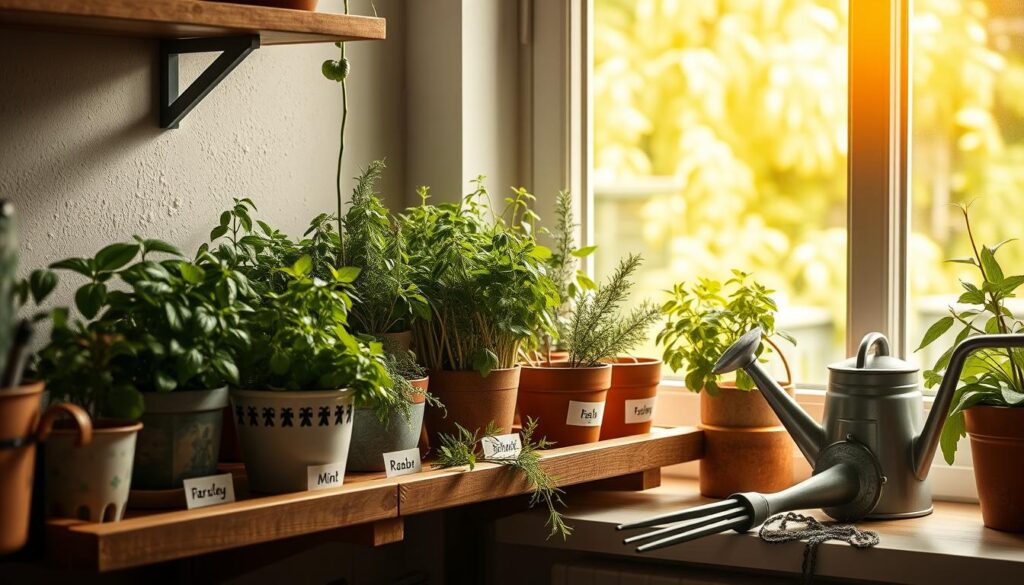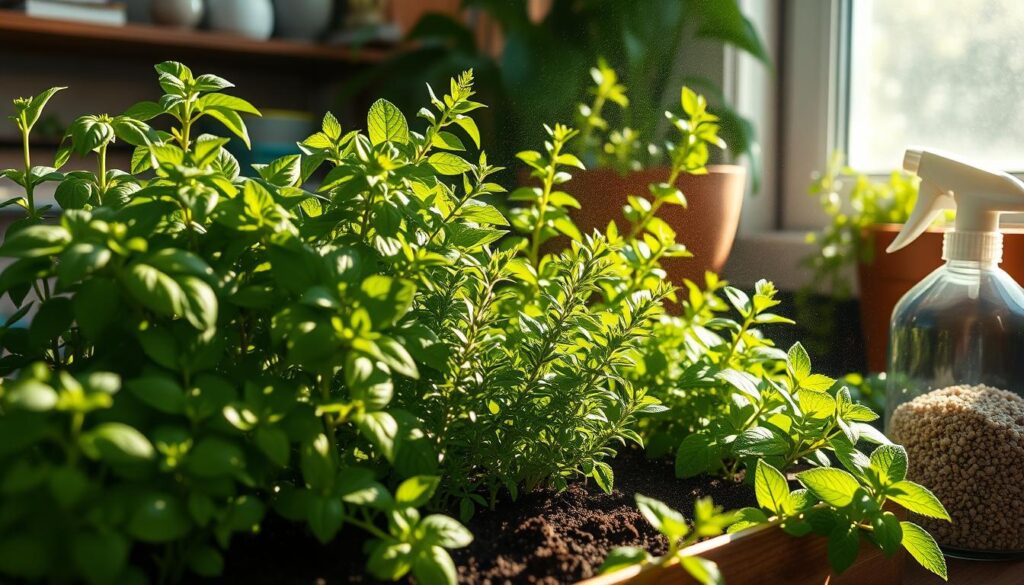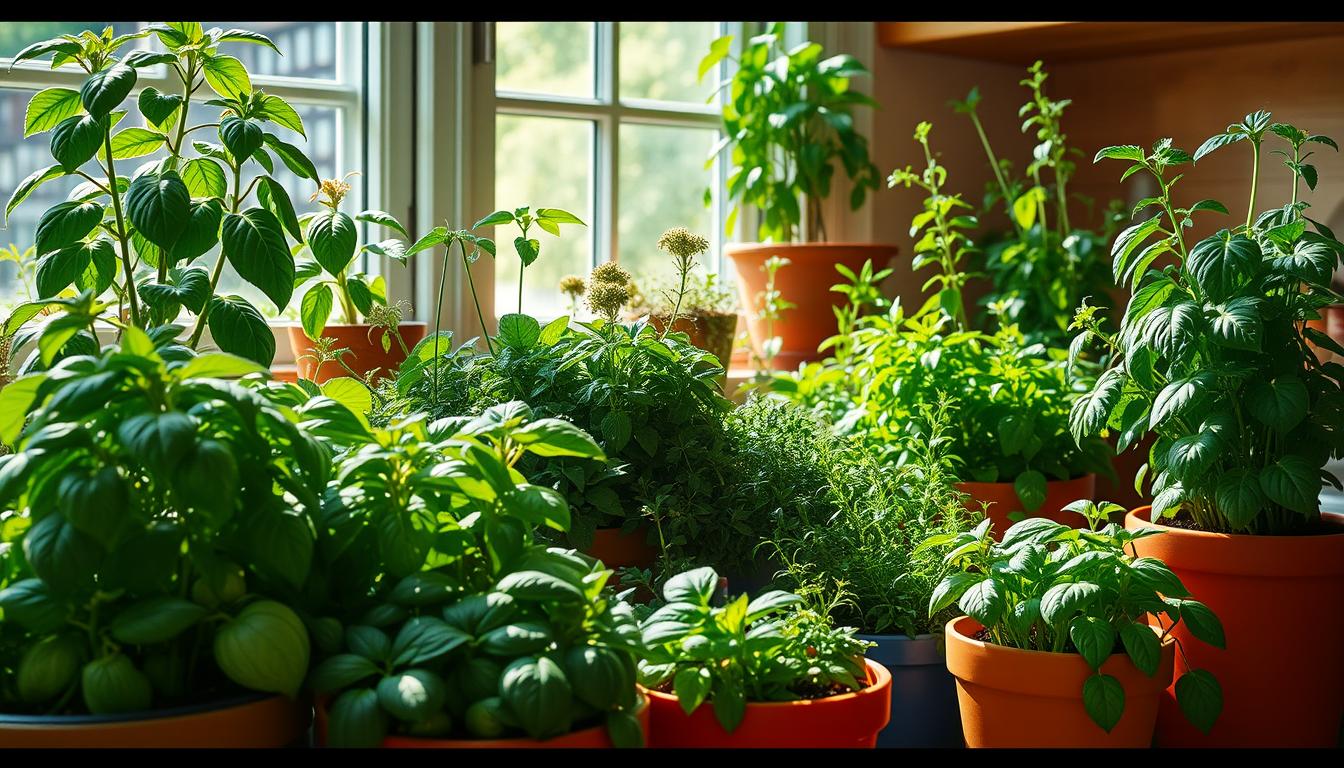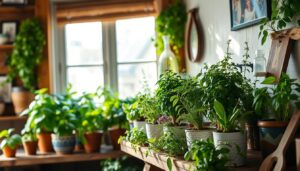Did you know the global indoor gardening market is set to hit $27.6 billion by 2027? This growth is driven by people wanting fresh, homegrown herbs and produce in small spaces. By using companion planting, you can make a garden that’s not just pretty but also fights pests and uses space well.
Key Takeaways
- Companion planting for indoor herbs can help control pests, optimize space, and promote overall plant health.
- Understanding which herbs complement each other is the key to designing a productive and aesthetically pleasing indoor herb garden.
- Factors to consider include plant size, growth habits, water and sunlight requirements, and the ability of certain herbs to repel common indoor pests.
- Basil, rosemary, and oregano make a great trio, while thyme, sage, and parsley also work well together.
- Proper maintenance, including watering, drainage, pruning, and harvesting, is essential for the success of your indoor herb garden.
Benefits of Companion Planting for Indoor Herbs
Adding companion planting to your indoor herb garden brings many benefits. By placing certain herbs together, you use natural pest repellents and make the most of space in your indoor garden.
Pest Control Benefits
Herbs like basil, mint, and marigolds have strong smells that keep pests away. These pests include whiteflies, aphids, and cabbage moths. By placing these natural pest repellents near your other herbs, you protect them without using harsh chemicals.
Space-Saving Companion Planting
Indoor gardens often have limited space. Space-saving companion planting helps use every inch well. For example, climbing beans can grow on taller plants like corn, saving space.
Low-growing herbs like thyme and chamomile fill in gaps between taller plants. This creates a full look and stops weeds from growing. It also helps maximize small spaces.
By choosing the right herbs and plants together, you get the pest control benefits and space-saving advantages of companion planting for your indoor herb garden.
Factors to Consider for Indoor Herb Companion Planting
When planning your indoor herb garden, think about the plant size compatibility and growth habits of your herbs. Choose plants that grow to similar sizes and spread out similarly. This way, they won’t fight over light, water, and nutrients. For example, chives and parsley are great together, while rosemary and sage should be kept apart.
Also, consider the water needs and sun exposure of your herbs. Don’t mix herbs that like different moisture levels. Also, put herbs that love sunlight together in bright spots. And, place those that prefer shade in shadier areas.
By thinking about spacing requirements and herb pairings for similar conditions, you can make a beautiful and healthy indoor herb garden. This approach makes the most of companion planting.
Plant Size and Growth Habits
- Pair compact herbs, like chives and parsley, together
- Group taller plants, such as rosemary and sage, separately to avoid overshadowing
- Consider the mature size and spreading patterns of your herbs
Water and Sunlight Requirements
- Avoid planting moisture-loving herbs with drought-tolerant varieties
- Group high-light herbs in the sunniest spots
- Place shade-loving plants in more shaded areas of your indoor garden
| Herb | Water Needs | Sun Exposure |
|---|---|---|
| Basil | Moist, well-drained soil | Full sun |
| Thyme | Drought-tolerant | Full sun to partial shade |
| Parsley | Moist, well-drained soil | Full sun to partial shade |
| Rosemary | Drought-tolerant | Full sun |
“By considering the plant size, growth habits, water needs, and sun exposure of your indoor herbs, you can create a thriving and harmonious herb garden that maximizes the benefits of companion planting.”
Herbs that Repel Common Indoor Pests
Having an indoor herb garden is fun but comes with challenges like pests. Luckily, some herbs can naturally keep pests away. These herbs are great for natural pest management.
Basil for Whiteflies and Aphids
Basil is a top choice for fighting off whiteflies and aphids. Its strong smell keeps these pests away. Planting basil with tomatoes and eggplants creates a safe zone. This cuts down on the need for harmful chemicals.
Mint for Cabbage Moths and Flea Beetles
Mint is also great at keeping pests away. Its unique smell stops cabbage moths and flea beetles from harming your plants. Adding mint to your garden helps keep your plants safe from these pests.
“Companion planting with herbs like basil and mint can be a game-changer for maintaining a healthy, pest-free indoor herb garden.”
Indoor Herb Garden Companion Planting: What Works Best
Creating an indoor herb garden with companion planting makes it thrive. The best pairings include basil, rosemary, and oregano, and thyme, sage, and parsley.
Basil, Rosemary, and Oregano
These Mediterranean herbs grow well together. Basil keeps pests away, rosemary likes dry conditions, and oregano fights weeds. This mix makes your indoor garden easy to care for.
Thyme, Sage, and Parsley
Thyme, sage, and parsley also work well together. They need similar conditions, fitting well in containers or raised beds. Thyme is tough, sage keeps pests away, and parsley draws in good bugs.
Companion planting is an excellent way to maximize the limited space of an indoor herb garden while also promoting the health and vitality of your plants.
Choosing the right herb combinations helps your indoor garden grow well with little work.

Creating an Indoor Herb Garden Layout
Designing the perfect indoor herb garden layout is crucial for making the most of your space. It also makes your garden look great. You can use containers, raised beds, or vertical gardening to grow your herbs. Where you place your herbs is very important.
Think about how each herb grows and what light it needs when planning your garden. Put taller herbs like rosemary and sage at the back or in the middle. Use lower-growing herbs such as thyme and chives along the edges or in front.
Vertical gardening is a great way to use space wisely. Try hanging baskets, tiered shelves, or wall-mounted planters. These can turn a small area into a lush indoor herb garden without taking up much floor space.
Planning is essential for a beautiful and useful indoor herb garden. Arrange your plants carefully to use space well. This way, you can enjoy a full indoor garden without it taking over your space.
“With careful planning, your indoor herb garden can be both beautiful and bountiful.”
Indoor Herb Garden Maintenance Tips
Keeping an indoor herb garden alive needs careful attention, especially with watering and soil drainage. Most herbs like soil that drains well and dries out a bit between waters. Too much water can cause root rot, so watch the soil and adjust your watering.
Add sand, perlite, or other materials to your potting mix for better drainage. This helps stop water from pooling and keeps your herbs healthy.
Watering and Drainage
Managing moisture is key for your indoor herbs. Don’t let the soil dry out completely, but don’t overwater either. Check the soil often and water when the top inch or two feels dry.
Letting the soil dry a bit between waters helps avoid root rot and encourages healthy growth.
Pruning and Harvesting
Trimming and picking your herbs regularly keeps them full and bushy. Cut off the biggest leaves or stems first, leaving the smaller ones to grow. This encourages new growth and stops your herbs from getting too long.
When you pick, use clean scissors or pruners. Make sure to leave a few inches of stem on the plant. This helps with regrowth and keeps your herbs strong.
Proper watering and drainage, along with regular pruning and harvesting, are the keys to keeping your indoor herb garden thriving and productive.
By following these easy tips, you can keep your indoor herbs fresh, tasty, and plentiful all year. Enjoy the benefits of your homegrown herbs right in your own home.
Indoor Herb Garden Companion Planting
Creating a thriving indoor herb garden is all about pairing herbs well. By choosing the right plants together, you can fight pests and use space wisely. Indoor herb companion planting uses the natural benefits of plants to make your garden lush and easy to care for.
There are many great herb pairs to try. Basil and tomatoes work well together, with basil keeping pests away and tomatoes shading the basil. But there are more combos to explore. Try rosemary with oregano or thyme, sage, and parsley together.
Think about the size, growth, and needs of each plant when planning your garden. This way, you can make a beautiful and useful indoor herb garden. Indoor herb companion planting lets you enjoy a garden full of flavors and scents.
| Herb Combination | Benefits |
|---|---|
| Basil and Tomatoes | Basil’s strong aroma deters pests, while tomatoes provide necessary shade for the basil. |
| Rosemary and Oregano | The robust, fragrant herbs thrive in similar growing conditions and complement each other’s flavors. |
| Thyme, Sage, and Parsley | This trio of herbs shares similar water and light requirements, creating a harmonious and visually appealing arrangement. |
Try indoor herb companion planting and see your garden grow with delicious flavors and lovely scents.
Troubleshooting Common Indoor Herb Garden Issues
Even with the benefits of companion planting, your indoor herb garden may face pest or disease issues. Watch out for aphids, spider mites, and powdery mildew. Use organic methods like insecticidal soap or neem oil to fix these problems. Good air flow, right watering, and keeping an eye on your plants can also help prevent and solve these issues.
If your indoor herbs look like they’re not doing well, check their growing conditions. Problems like inadequate light, improper watering, or nutrient deficiencies can make plants look bad or stop growing. Fix these issues by giving them more sunlight, changing how often you water them, or adding a balanced fertilizer. With some care, you can often revive even the most stressed indoor herbs and optimize growing conditions.
Pests and Disease Management
- Identify and address common indoor herb pests like aphids, spider mites, and powdery mildew
- Use organic pest management solutions like insecticidal soap or neem oil
- Maintain good air circulation and monitor plants regularly to prevent and manage issues
Reviving Struggling Plants
- Assess growing conditions like light, water, and nutrients
- Adjust as needed, such as moving to a sunnier spot or modifying watering schedule
- Provide a balanced fertilizer to address any nutrient deficiencies
- Offer extra care and attention to revive stressed indoor herbs
“With a little TLC, you can often revive even the most stressed indoor herbs.”

Conclusion
By using companion planting, you can make a thriving indoor herb garden. This garden will give you fresh, tasty herbs all year. Pairing herbs well helps control pests and makes the most of your space. It also makes your plants healthier and more productive.
Choosing the right herbs and designing your garden well brings many rewards. Indoor herb garden success means more than just fighting pests and saving space. It’s about growing your herbs in a way that’s good for the planet.
Start with indoor herb companion planting to bring out the best in your garden. By creating a balanced environment at home, you’ll get a lot of herbs. And you’ll feel great about growing a lively, self-sustaining indoor herb garden.
FAQ
What are the benefits of companion planting for indoor herbs?
How can companion planting help manage pests in an indoor herb garden?
How can companion planting help maximize space in an indoor herb garden?
What factors should you consider when selecting herbs for companion planting in an indoor garden?
How can basil and mint help control pests in an indoor herb garden?
What are some of the best herb combinations for indoor gardens?
How should you design the layout of an indoor herb garden for optimal companion planting?
What are some tips for maintaining a healthy indoor herb garden with companion planting?
Source Links
- A How-to Guide: Companion Planting with Herbs – https://www.almanac.com/content/companion-planting-herbs
- Companion Planting Herbs for Pest Control – https://theherbgardener.blogspot.com/2014/07/companion-planting-and-other-tactics.html
- 11 Best Herb Pairings to Grow Together in Pots or Containers – https://www.epicgardening.com/herbs-together-pots/




